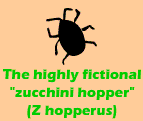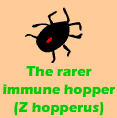The Case of the Undying Hoppers
 In her tiny garden, Mary planted 3 tomato plants, 5 carrots and one big sprawling zucchini vine. Early in the summer everything seemed to be going well, but in mid-summer the zucchini hoppers invaded. These bugs like to hide under leaves, hopping out only to eat zucchini or scare small children. And they breed like crazy, a new generation every month. Soon Mary won't even have enough zucchini to supply her 20 closest friends. Something has to be done...
In her tiny garden, Mary planted 3 tomato plants, 5 carrots and one big sprawling zucchini vine. Early in the summer everything seemed to be going well, but in mid-summer the zucchini hoppers invaded. These bugs like to hide under leaves, hopping out only to eat zucchini or scare small children. And they breed like crazy, a new generation every month. Soon Mary won't even have enough zucchini to supply her 20 closest friends. Something has to be done...
 Mary's friendly local pesticide supplier recommended a new, highly toxic pesticide called Hopper-B-Gone. This pesticide is applied as a misting spray and kills almost all of the hoppers it lands on -- unless they happen to be hiding under leaves, or they happen to have a natural immunity. The salesman assures her that very few hoppers have natural immunity, not more than 20% in any case, so she should definitely be able to get rid of most of them.
Mary's friendly local pesticide supplier recommended a new, highly toxic pesticide called Hopper-B-Gone. This pesticide is applied as a misting spray and kills almost all of the hoppers it lands on -- unless they happen to be hiding under leaves, or they happen to have a natural immunity. The salesman assures her that very few hoppers have natural immunity, not more than 20% in any case, so she should definitely be able to get rid of most of them.
Being rather contrary, Mary is not immediately convinced. She decides to see what will happen if she just lets her garden grow, without any pesticides:
How did Mary's garden fare this time? The average result is about 90 hoppers, with between 15% and 25% being immune to hopper-be-gone -- about the same percentage of immune hoppers as at the beginning of the growing season. (If you got something radically different, you might want to try again -- the applet runs a little different every time).
Shocked and appalled at the carnage, Mary decides to give the pesticide a try. You can reload the applet below to experiment with timing the sprays. Can you get rid of all of the hoppers?
Compare the results in the two graphs above. What's happening to the percentage of immune bugs when you apply pesticide?
Copyright University of Maryland, 2007
You may link to this site for educational purposes.
Please do not copy without permission
requests/questions/feedback email: mathbench@umd.edu